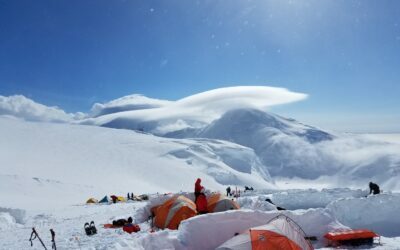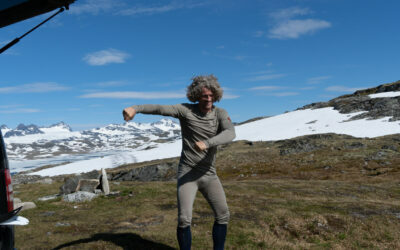In Norway, we call alpine touring topptur – peak touring. While that’s a comparatively new term, there’s nothing new about summiting mountains on skis. It’s true that the term “topptur” has gradually been watered down. In our opinion, it’s become somewhat misleading. A little like the word “powder” isn’t as sacred as it once was. But that’s for another day.
You don’t have to chase maximum altitude for good skiing. Many of our most memorable skiing days haven’t involved conquering peaks at all but yo-yoing wherever the best snow is – preferably in the forest. It could be argued that the term “alpine touring” is more accurate than “topptur” for what we’re going to describe in this article: days out where the focus is the skiing, in alpine terrain generally. This includes avalanche terrain.
Avalanche terrain
Avalanche terrain is defined as terrain steep enough for avalanches to occur (around 30° and steeper), and terrain where the avalanche can freely run off into (this can be below 30°, but will be adjacent to slopes that are 30° or steeper). The most important thing you can do to avoid avalanches is to avoid avalanche terrain. If you’re going to do it anyway, then you should be 100% sure you can recognise it – break-off points, gradients and terrain traps – and deal with it. If you don’t have this knowledge, we recommend seeking out a qualified guide or instructor and get proper training. Alternatively, find yourself a qualified mentor, friend or acquaintance whose had some genuine education, rather than “experience” alone. Join them on a tour; soak up knowledge like a sponge! The Norwegian Tourist Association’s mountain sports groups and the Red Cross also have good beginner courses. All of these can also give you a lot of useful advice as well as teaching you navigation and avalanche-prevention skills.The contents of your pack are vital
Alpine touring often takes place in avalanche terrain. And it’s basically a given that you’ll be somewhat off the beaten track, where it’s difficult to get assistance. This is something to keep in mind when choosing a pack and filling it appropriately. So what should be in there?Be prepared for the unexpected
It’s a good idea to bring an extra change of underclothes, socks, a hat and, especially, gloves or mittens. Plenty of food’s important – this isn’t simply fuel for the ascent, it keeps the mood lifted in an environment where we expend an enormous amount of energy. No one likes you when you’re hangry. An old seating mat also comes in handy during the lunch break.
Those we’ve spoken to say that responsible skiers will take:
Avalanche rescue equipment is completely mandatory. A windsack, some rope for hauling and repairs, spare parts, multi-tools, good first aid equipment, a map and compass and a mobile phone – these are things you should go in automatically. Help’s often far away, so you should be confident in your party’s competence and equipment. Experienced mountaineers, rescue teams and professional guides leave nothing to chance when packing their bags.
In general, it makes sense to be sure that as much of the stuff you take is light, able to take a beating, and versatile, preferably covering several areas of use – an important trick of the trade.
Sports tape, clingfilm, a rubbish bag and multi-tool, for example, can be used for many things: first aid, repairs, warmth, and storage.
FIRST THINGS FIRST: Remember avalanche beacon, shovel and search probe
ASSS – “Always shovel, sender-receiver and search-probe”
ASSS is the law: Always Spade, sender-receiver and search-probe. This is about as self-explanatory as it gets. You should always carry a shovel, an avalanche beacon (transmitter/receiver), and a search probe if you’re going into the mountains. Before we talk about anything else, it’s important to spend a moment on this. It’s selfish to go touring without having this equipment in your bag. You and the others in your party should all be able to help each other if something happens. The more people that carry this basic, standard, equipment, and have the knowledge of how to use it, the more prepared the entire mountain is: everyone can contribute if someone nearby is caught in an avalanche or injured.Safety equipment
Helmet
Helmets are cool. They can save your life. This is why they’re considered standard equipment. New helmets are light, comfortable, and multi-use, approved for both skiing and climbing. A helmet protects against head injuries. You will categorically want one in an avalanche. Find a helmet that fits your head, works for your use, and fits your ski goggles. It’s a good idea to take your goggles with you when to go shopping for a new helmet.First aid and other life-saving equipment
We can’t count on rescue teams reaching us in the mountains, and certainly not in good time. A first aid kit and something to keep us warm can therefore be essential to enable us to deal with unexpected situations or injuries.Bivvy bag and down jacket
The bivouak bag (aka “bivvy bag” or “windsack”) can be wrapped around an injured skier to prevent hypothermia. A warm jacket can also be used as a pillow or for cushioning, even as a neck collar, if necessary, when transporting a casualty. Hypothermia is a constant danger in the mountains. These things can save lives. Furthermore, the bivvy bag can be used to transport the injured. It’s also very, very handy in wind and storm: it turns into a proper sauna if you sit together inside it for lunch under cover.Clingfilm
Clingfilm’s great in first aid kit. What we do is saw a roll in half and take a half with us. It weighs little and takes up little space, but can be used for so many things. Among others, for repairing things. The beauty of clingfilm is that one side will almost always be clean enough to use on injuries. It can be used to wrap large open cuts, seal punctures on the skin and wrap burns. Mechanically, it can be used to splint and as a support bandage, and so much more. If someone’s very cold, you can wrap them in it too, and they’ll quickly warm up. Spade shafts, poles and search rods work well as splints in case of broken injuries.Ski straps
Rubber ski straps, made by Åsnes among many others, are completely brilliant. They can be used for everything. They’re great for repairs and hanging things, and for medical emergencies: splints and tourniquets.Rubbish bags (bin liners)
Rubbish bags can serve as a sort of cross between a bivvy bag and cling film. They’re an emergency sleeping bag, instant waterproofing (they can even go in boots) and they way nothing whatsoever. You can even use them to collect rubbish, so it’s win-win. It really doesn’t hurt to have bin-bags in your ski-bag. With a little creativity and a solution-oriented approach, you can treat a number of injuries with relatively few items in the your kit. Find solutions where things have multiple uses. Take some courses in first aid; learn the art of improvising with what you have.First aid
Do you know what’s required if you run into trouble? As always, it’s a question of preparation. You plan. You pack sensibly. If you’ve practiced first aid and you’re equipped to get in touch with the rescue services, you are, at least, somewhat prepared.
First aid kit essentials – the minimum, in waterproof packaging:
Consider also bringing:
Packing list – alpine touring bag

Preparing for Åsnes Expedition Amundsen
Dreaming of an adventure in the winter mountains? Or a lover of endurance races? Maybe Åsnes Expedition Amundsen is for you. But you’ll need to be ready.

Replacing and renewing glue on skins
Unfortunately, skin glue doesn’t last forever. The skin itself, on the other hand, only gets better and better until it wears out. So if you replace the old glue, your skins can last many years. Moribund glue can be replaced, either with tape or sheets, or from a tube. We explain how.

Wool is completely excellent
Norway’s famous for its changeable weather. Even in summer it can vary from 5° to 30° C. Such variable weather makes it difficult to know how to dress – which is why we say “ull er gull”: wool is gold. Wool keeps you warm in winter, and regulates your temperature in the summer. Wool is the best. A billion sheep can’t be wrong.

How to feed a hunting dog
Correct nutrition is the alpha and omega for a healthy, strong and happy hunting dog performing to its limits day after day in the mountains. A well-trained hunting dog can quickly cover more than 60 km in hilly terrain, marshes and woods. So if you’re out for a number of days, feeding is everything.

Dressing for adventure: what to wear in the wild
Norwegian grandmothers have it right: always wear wool against the skin. Beginning with wool as the first layer, the three-layer principle applies. Step this way for a guide to wrapping up warm in the wild.

Storing skis until next season
Putting your skis to bed for the summer, clean and protected, is a chore, but it’s got to be done. It’s more than worth it. Here we break down the basics. Your skis will thank you. Actually, you’ll thank yourself come the first snow – for all sorts of reasons…